





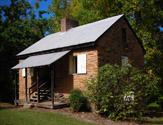









Magnolia Eden
Producing Bountiful Harvests from Heirloom Seed
When making spring gardening plans, it is easy for gardeners to be overwhelmed by the options presented to them on the seed racks at their local garden centers and big chain box stores or within the pages of mail order catalogues. The promise of gigantic hybrid tomatoes or unheard of yields of beans from the latest introduction can be quite alluring, but gardeners need not dismiss the reliability of heirloom vegetables. And the American South happens to be home to some of the most reliable and best-tasting heirlooms in circulation.

Heirloom vs. Hybrid
Heirlooms and hybrids are distinctly different even though some hybrids have become household names due to their longevity. Generations of selective breeding have gone into the production of a hybrid. "During hybrid selections," Dr. David Bradshaw, Professor Emeritus of Horticulture at Clemson University, explains, "breeders will cross two plants with good characteristics and back cross to fix points. Each time they back cross, they narrow the gene base. This can make them more susceptible to diseases and so forth because of the diminished gene pool."
As for heirlooms, they have typically been around for quite some time---a century or more in many cases---and are open-pollinated and propagated from harvested seeds. Because natural selection has a tendency to eliminate weak plants with the passing of time, Bradshaw says that heirlooms "may not have massive production, but they are likely to demonstrate resistance or tolerance to insects and disease." Additionally, each heirloom vegetable has a story of its own, and Bradshaw says, "Memory banking involves selling a seed but also the family history. That's what's part of the appeal."
In her book, Heirloom Seeds and Their Keepers: Marginality and Memory in the Conservation of Biological Diversity, Virginia D. Nazarea wrote, "The American South is a special place where many of the 'old-fashioned' values are still very much intact, in fact unabashedly flaunted. The home and the garden are central to the Southern sense of place---a hearty 'Ya'll come back and see us, ya' hear' is frequently heard instead of 'Good-bye, stay in touch'---and, in this milieu, seeds connect people to place and past to present. Clearly, an impersonal seedsaving system would be superfluous and out of place."
Heirlooms and hybrids are distinctly different even though some hybrids have become household names due to their longevity. Generations of selective breeding have gone into the production of a hybrid. "During hybrid selections," Dr. David Bradshaw, Professor Emeritus of Horticulture at Clemson University, explains, "breeders will cross two plants with good characteristics and back cross to fix points. Each time they back cross, they narrow the gene base. This can make them more susceptible to diseases and so forth because of the diminished gene pool."
As for heirlooms, they have typically been around for quite some time---a century or more in many cases---and are open-pollinated and propagated from harvested seeds. Because natural selection has a tendency to eliminate weak plants with the passing of time, Bradshaw says that heirlooms "may not have massive production, but they are likely to demonstrate resistance or tolerance to insects and disease." Additionally, each heirloom vegetable has a story of its own, and Bradshaw says, "Memory banking involves selling a seed but also the family history. That's what's part of the appeal."
In her book, Heirloom Seeds and Their Keepers: Marginality and Memory in the Conservation of Biological Diversity, Virginia D. Nazarea wrote, "The American South is a special place where many of the 'old-fashioned' values are still very much intact, in fact unabashedly flaunted. The home and the garden are central to the Southern sense of place---a hearty 'Ya'll come back and see us, ya' hear' is frequently heard instead of 'Good-bye, stay in touch'---and, in this milieu, seeds connect people to place and past to present. Clearly, an impersonal seedsaving system would be superfluous and out of place."
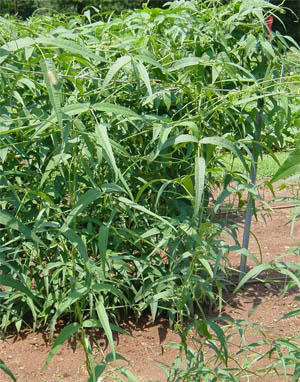
Bradshaw agrees with Nazarea's views, indicating that an interest in heirloom vegetables was instilled in him at an early age by his grandfather. A native of Virginia's peanut country near Tidewater, Bradshaw says, "I got interested when I was 5. My grandfather gave me willowleaf butterbeans and said if I grew them I'd never go hungry." A testament to his grandfather's declaration, Bradshaw recalls that his grandfather grew willowleaf butterbeans during the Great Depression. A number of heirloom cultivars have been in Bradshaw's family for generations, spanning some 150 years.
Obtaining Seed
Gardeners can certainly acquire heirloom seeds from a variety of sources, including George W. Park Seed Company, Inc. and Thompson-Morgan, Inc., but one of the most extensive inventories available is offered by Anderson, South Carolina-based Heavenly Seed, LLC. Though this company's listing includes a number of old-time hybrid favorites such as 'Merit' corn and 'Big Boy' tomatoes, Heavenly Seed's heirloom selections vary from 'Green Globe' artichokes and 'Valencia' tomatoes to the impressive collection of Dr. Bradshaw, taking the guesswork out of determining what will perform well in the South.
Mike Watkins, owner of Heavenly Seed, says, "In September 2009, I retired as Executive Vice President of the South Carolina Foundation Seed Association and decided to fulfill my dream of starting my own seed business with a focus on the finest open-pollinated heirloom and organic vegetable seed available." Watkins, a native of Bishopville, South Carolina, has nearly forty years experience in the seed industry.
Cultivating a Legacy
Having worked with Dr. Bradshaw for years, Watkins plans to offer a number of heirloom varieties from the Bradshaw collection. Bradshaw has spent decades collecting and growing heirloom vegetables, and has preserved the stories behind the items in his collection to the delight of gardeners who appreciate the history accompanying an heirloom seed purchase. Heavenly Seed's catalogue contains a number of these stories.
A most intriguing account is given of one of Heavenly Seed's bean selections. In 1802, a settler in Kentucky killed a wild turkey and discovered two unusual seeds in the bird's gizzard while cleaning it. Curious, the man planted the seeds and, some two hundred years later, turkey gizzard beans are still admired for their nutty flavor and appaloosa pattern seeds. When asked whether such an old cultivar could have deviated from its original form and characteristics with the passing of time, Dr. Bradshaw replied, "Since beans and peas are primarily self-pollinated, consistency can be expected year after year. This is a true breeding variety."
Obtaining Seed
Gardeners can certainly acquire heirloom seeds from a variety of sources, including George W. Park Seed Company, Inc. and Thompson-Morgan, Inc., but one of the most extensive inventories available is offered by Anderson, South Carolina-based Heavenly Seed, LLC. Though this company's listing includes a number of old-time hybrid favorites such as 'Merit' corn and 'Big Boy' tomatoes, Heavenly Seed's heirloom selections vary from 'Green Globe' artichokes and 'Valencia' tomatoes to the impressive collection of Dr. Bradshaw, taking the guesswork out of determining what will perform well in the South.
Mike Watkins, owner of Heavenly Seed, says, "In September 2009, I retired as Executive Vice President of the South Carolina Foundation Seed Association and decided to fulfill my dream of starting my own seed business with a focus on the finest open-pollinated heirloom and organic vegetable seed available." Watkins, a native of Bishopville, South Carolina, has nearly forty years experience in the seed industry.
Cultivating a Legacy
Having worked with Dr. Bradshaw for years, Watkins plans to offer a number of heirloom varieties from the Bradshaw collection. Bradshaw has spent decades collecting and growing heirloom vegetables, and has preserved the stories behind the items in his collection to the delight of gardeners who appreciate the history accompanying an heirloom seed purchase. Heavenly Seed's catalogue contains a number of these stories.
A most intriguing account is given of one of Heavenly Seed's bean selections. In 1802, a settler in Kentucky killed a wild turkey and discovered two unusual seeds in the bird's gizzard while cleaning it. Curious, the man planted the seeds and, some two hundred years later, turkey gizzard beans are still admired for their nutty flavor and appaloosa pattern seeds. When asked whether such an old cultivar could have deviated from its original form and characteristics with the passing of time, Dr. Bradshaw replied, "Since beans and peas are primarily self-pollinated, consistency can be expected year after year. This is a true breeding variety."
Willowleaf Butterbeans
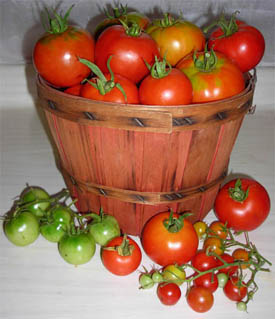
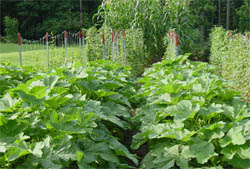
Choppee Okra
Many of the selections in Bradshaw's collection have come from individuals all too eager to share their family's prized vegetables, but obtaining one variety---the turtle pea---from the Hernandez Family in Lexington, Kentucky, required some persistence and persuasion. J. E. Hernandez had immigrated to the United States from western Cuba's Pinar del Rio Province, bringing with him turtle peas which he grew and dried for the principal purpose of preparing black beans and rice. Bradshaw learned of the variety from one of his former graduate students, Hernandez's grandson, who indicated that his grandfather had brought them over when he was 14. He says, "My former graduate student talked to him for three years before he let him bring just a handful of seeds to me." For decades, the seeds had been closely guarded by Mr. Hernandez, who practically lived off of black beans and rice. Bradshaw adds, "The old gentleman was in his 90s when he gave me the seed."
A number of heirloom vegetables have been grown throughout the South, but are known by different names in different locales. Greasy cut short beans, a favorite for "leather breeches" (beans which have been hung on a string on the porch for drying and eventually soaked overnight and slow-cooked with a ham hock or fat back for seasoning), are known as greasy backs in some areas, but it is speculated that some ten or twelve variants of these beans might even be grown.
Bradshaw's healing squash is another example of a variety that is known by other names as well. Bradshaw's source for the edible gourd was Edith and Bill Gambrel of Clayton, Georgia. Originating in Italy and maintained in the family for nearly 200 years, the gourd has the amazing ability to heal over and continue to grow after as much as half a fruit has been cut off for eating. Best eaten when the fruits are young (15-18 inches), healing squash can mature to four feet in length!
Healing squash are referred to by Mrs. Connie Chappell as gourd beans in The Foxfire Book of Appalachian Cookery. Mrs. Chappell recounts how she first learned of the gourd in the 1940s when she hoed corn for a farmer and his wife near Hiawassee, Georgia. The lady of the house prepared some of the gourd beans for lunch, and the couple wound up sharing seeds with Mrs. Chappell. If the Gambrels' ancestors were the first to grow healing squash in northeast Georgia, the gourd is a prime example of how heirloom vegetables persist for generations through seedsaving and sharing.
Bradshaw's healing squash is another example of a variety that is known by other names as well. Bradshaw's source for the edible gourd was Edith and Bill Gambrel of Clayton, Georgia. Originating in Italy and maintained in the family for nearly 200 years, the gourd has the amazing ability to heal over and continue to grow after as much as half a fruit has been cut off for eating. Best eaten when the fruits are young (15-18 inches), healing squash can mature to four feet in length!
Healing squash are referred to by Mrs. Connie Chappell as gourd beans in The Foxfire Book of Appalachian Cookery. Mrs. Chappell recounts how she first learned of the gourd in the 1940s when she hoed corn for a farmer and his wife near Hiawassee, Georgia. The lady of the house prepared some of the gourd beans for lunch, and the couple wound up sharing seeds with Mrs. Chappell. If the Gambrels' ancestors were the first to grow healing squash in northeast Georgia, the gourd is a prime example of how heirloom vegetables persist for generations through seedsaving and sharing.
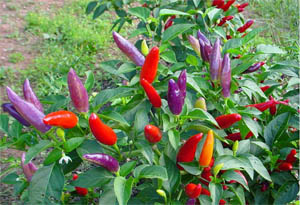
African Surprise Pepper
Prolific and quite hot, this colorful pepper came to Dr. David Bradshaw from the west central African country of Gabon where it is a staple in the diet of most people.
Prolific and quite hot, this colorful pepper came to Dr. David Bradshaw from the west central African country of Gabon where it is a staple in the diet of most people.
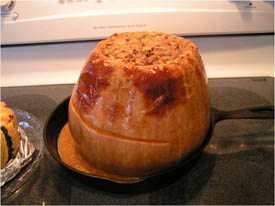
Seminole Pumpkin stuffed and baked
The venerable Seminole pumpkin resulted from what Bradshaw refers to as "unintentional selection." A staple of the Seminoles' diet, the pumpkin has endured nearly two centuries of disease, heat and humidity. Bradshaw says the Seminoles could not dig holes to preserve them because of the high water table, and South Florida's humidity would have prohibited sun-drying. Bradshaw explains, "If they opened one in October and saved the seeds, rodents would have probably gotten them. Or insects or fungus. So they would eat on them throughout the fall and winter, and the longest keeping ones would be the last to be eaten. The best keepers provided the seed by unintentional selection."
Further substantiating the role of the pumpkin in the survival of the Seminoles, Richard J. Campbell wrote in his April 17, 2010 column in The Miami Herald, "This unassuming pumpkin was also at the center of a pivotal act of the Second Seminole War. When Chief Chekika was tracked down and killed by the U.S. Army after his raid on Indian Key, his body was hung from the trees of a small hammock west of Miami. To add further emphasis to this act, all of the Seminole pumpkins hanging from the trees in the hammock were shot to the ground. More than symbolic, this was a most effective way to cause starvation among these Everglades renegades."
Bradshaw declares the Seminole pumpkin "is the best pumpkin you'll ever eat." About the size of a basketball, the exceptionally long-lasting pumpkins are noted for their variegated foliage, light salmon pink rind and thick, beige flesh. Bradshaw recalls giving one to a former Clemson University president who "kept it on his table at room temperature from September to November of the following year." Then he cut it open, gave Bradshaw some seed and made pies out of the flesh. "I have kept 'em for almost two years," Bradshaw says.
Further substantiating the role of the pumpkin in the survival of the Seminoles, Richard J. Campbell wrote in his April 17, 2010 column in The Miami Herald, "This unassuming pumpkin was also at the center of a pivotal act of the Second Seminole War. When Chief Chekika was tracked down and killed by the U.S. Army after his raid on Indian Key, his body was hung from the trees of a small hammock west of Miami. To add further emphasis to this act, all of the Seminole pumpkins hanging from the trees in the hammock were shot to the ground. More than symbolic, this was a most effective way to cause starvation among these Everglades renegades."
Bradshaw declares the Seminole pumpkin "is the best pumpkin you'll ever eat." About the size of a basketball, the exceptionally long-lasting pumpkins are noted for their variegated foliage, light salmon pink rind and thick, beige flesh. Bradshaw recalls giving one to a former Clemson University president who "kept it on his table at room temperature from September to November of the following year." Then he cut it open, gave Bradshaw some seed and made pies out of the flesh. "I have kept 'em for almost two years," Bradshaw says.
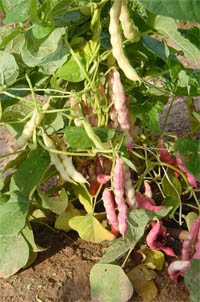
Share the Harvest, Share the Seeds
When growers of heirloom vegetables give away produce or serve a home-cooked meal, their fresh pole beans and vine-ripened tomatoes or stuffed peppers and pumpkin pies are all potential conversation pieces! The history behind heirloom vegetables is bound to fascinate guests as much as a coveted recipe. Best of all, gardeners will play a role in preserving important vegetable cultivars and contributing to gardening diversity when they opt to grow heirlooms and share their produce and seeds.
When growers of heirloom vegetables give away produce or serve a home-cooked meal, their fresh pole beans and vine-ripened tomatoes or stuffed peppers and pumpkin pies are all potential conversation pieces! The history behind heirloom vegetables is bound to fascinate guests as much as a coveted recipe. Best of all, gardeners will play a role in preserving important vegetable cultivars and contributing to gardening diversity when they opt to grow heirlooms and share their produce and seeds.
White Hull Pink Tip Beans
All photographs courtesy of Craig Weiner and Dr. David Bradshaw unless otherwise stated.
BIBLIOGRAPHY
Richard J. Campbell, "Seminole pumpkin has a rich history," The Miami Herald, March 28, 2010.
Virginia D. Nazarea, Heirloom Seeds and Their Keepers: Marginality and Memory in the Conservation of Biological Diversity (Tucson: University of Arizona Press, 2005).
Linda Garland Page and Eliot Wigginton (eds.), The Foxfire Book of Appalachian Cookery (New York: E. P. Dutton, Inc., 1984).
OTHER SOURCES
Interview with Dr. David Bradshaw and Mike Watkins in Clemson, South Carolina, on March 16, 2010
Richard J. Campbell, "Seminole pumpkin has a rich history," The Miami Herald, March 28, 2010.
Virginia D. Nazarea, Heirloom Seeds and Their Keepers: Marginality and Memory in the Conservation of Biological Diversity (Tucson: University of Arizona Press, 2005).
Linda Garland Page and Eliot Wigginton (eds.), The Foxfire Book of Appalachian Cookery (New York: E. P. Dutton, Inc., 1984).
OTHER SOURCES
Interview with Dr. David Bradshaw and Mike Watkins in Clemson, South Carolina, on March 16, 2010
Author: Greg Freeman. Published May 12, 2010.
Copyright
Southern Edition
All Rights Reserved
Southern Edition
All Rights Reserved
All materials contained on this site, including text and images, are protected by copyright laws and may not be reproduced without prior written permission from the publisher. Where applicable, use of some items contained on this site may require permission from other copyright owners.
Fair Use of text from SouthernEdition.com is permitted to the extent allowed by copyright law. Proper citation is requested. Please use this guide when citing a Southern Edition article.
Contact Greg Freeman or SouthernEdition.comFair Use of text from SouthernEdition.com is permitted to the extent allowed by copyright law. Proper citation is requested. Please use this guide when citing a Southern Edition article.